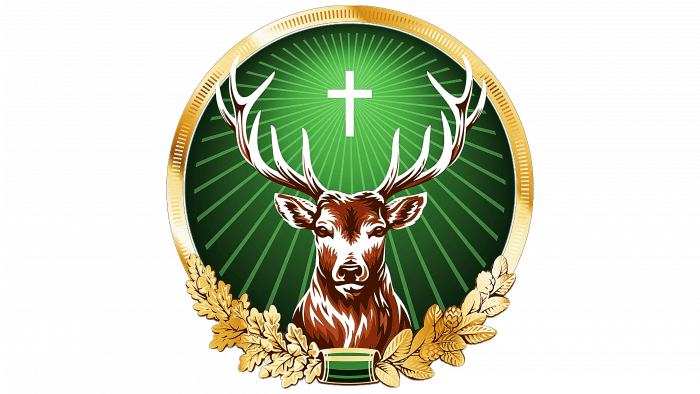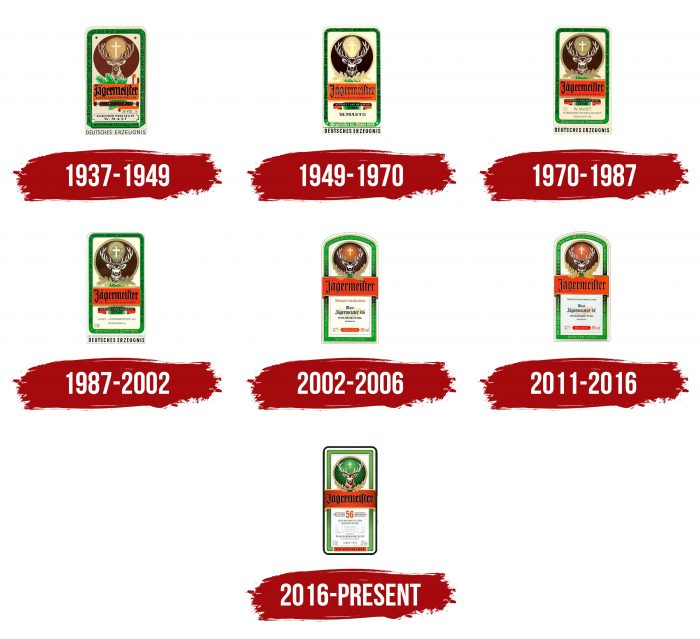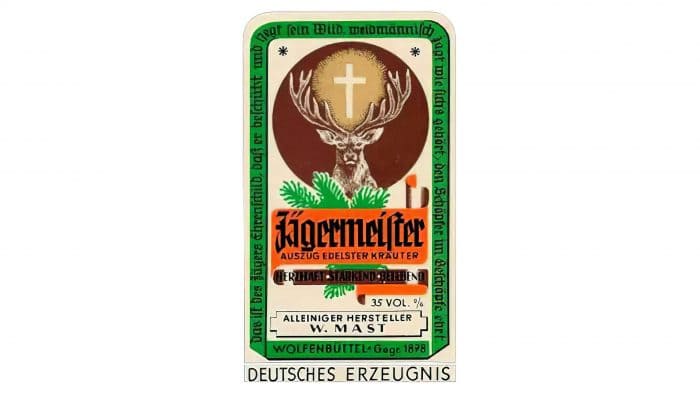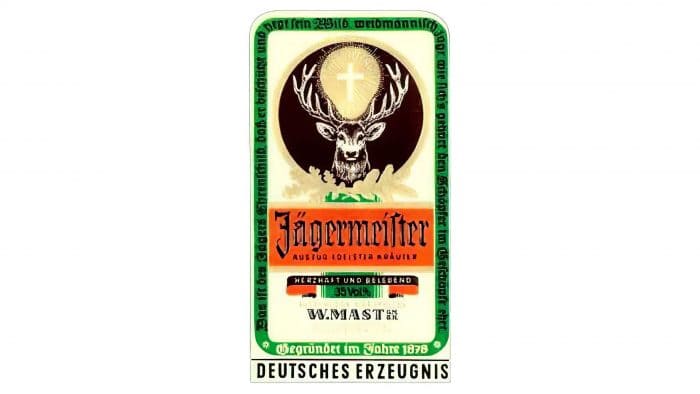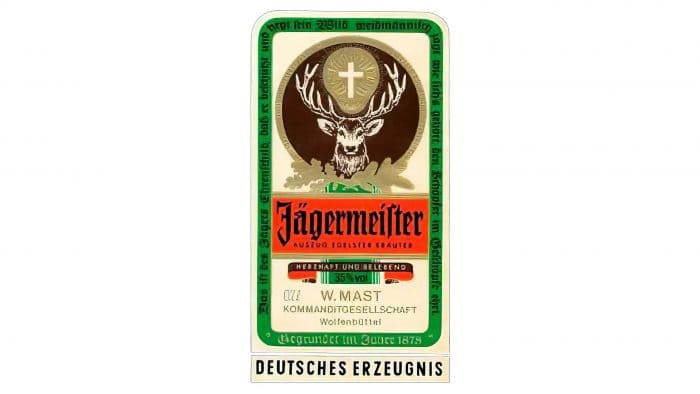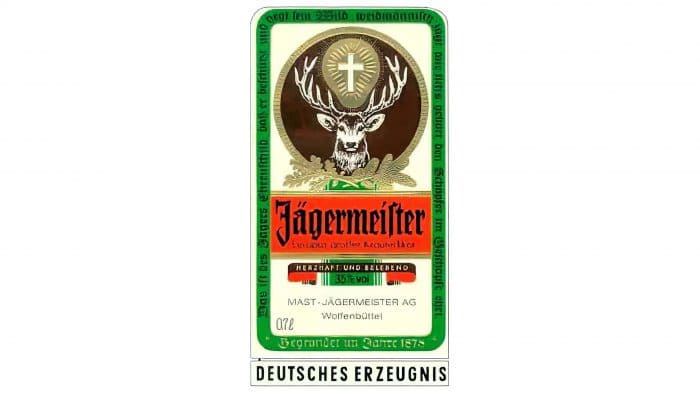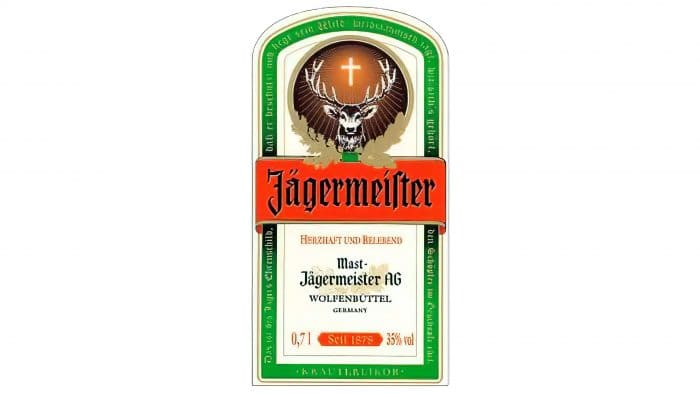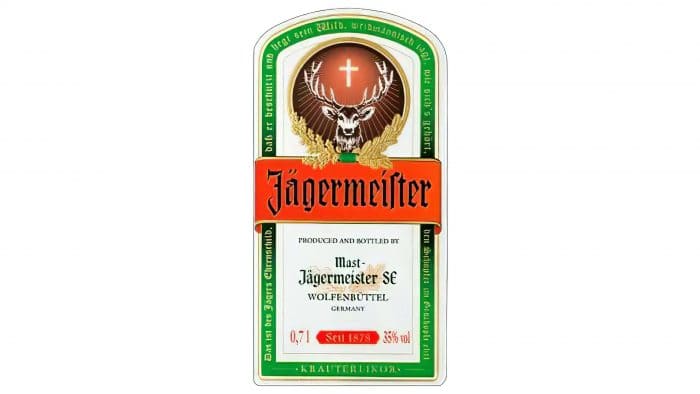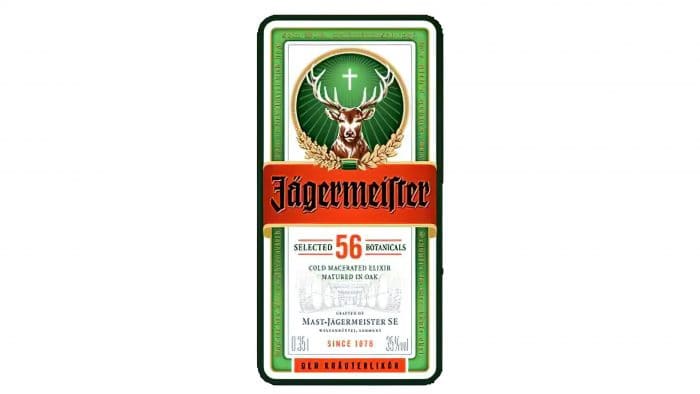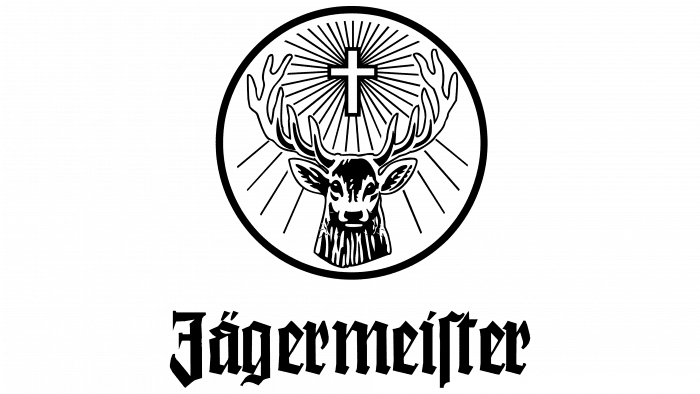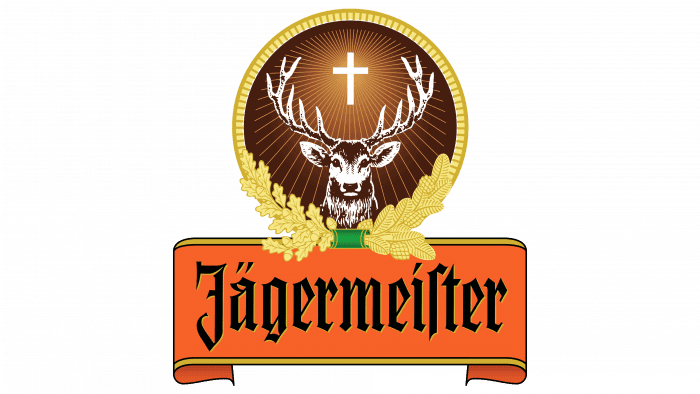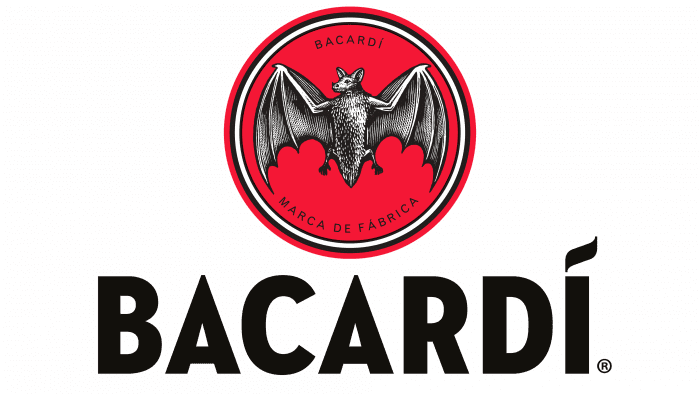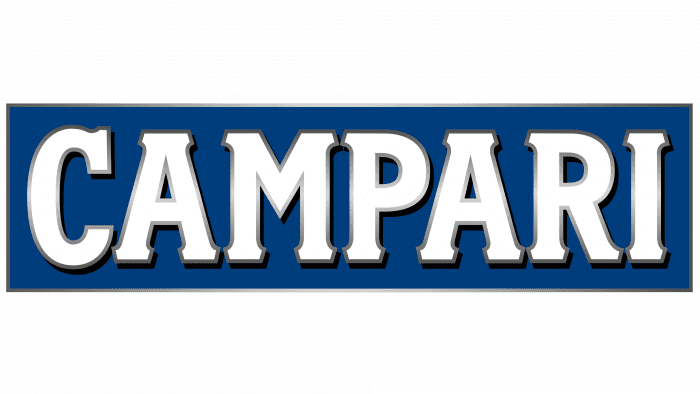The Jagermeister emblem reflects the brand’s connection and value for the health of the strong German alcoholic drink made from an infusion of 56 herbs. The emblem is dedicated to Bishop Hubertus, the patron saint of hunters, linking the brand to the history of its origin and reflecting the uniqueness of the drink.
Jagermeister: Brand overview
Jagermeister is a trademark of a 35% herbal liqueur based on 56 herbs. It has been produced since 1934 at the Mast-Jägermeister SE factory, which was opened in 1878 in Wolfenbuttel, Germany. The liqueur is an individual development and belongs to the bitters category. Since 1970, the company’s flagship product has been exported and supplied to dozens of countries, making visual identification extremely important for it.
Meaning and History
The progenitor of the alcoholic drink is considered to be Curt Mast, who developed it as a pharmaceutical remedy that improves digestion. The exact recipe of the liqueur is a commercial secret and is not disclosed. It is only known that bark, roots, flowers, leaves, and other parts of plants are poured with an alcoholic product and placed in wooden oak barrels for about a year. Then, the contents are drained, filtered, and sealed in bottles with original labels.
They feature the head and powerful torso of a deer with a cross between its antlers. This image is the emblem of the strong drink. It was proposed by Curt Mast and dedicated to Saint Hubert, the patron saint of all hunters. The story of the original emblem is connected with the ancient legend of the jäger-monk, the former Count Hubert of Liège.
Once, being in the Christmas forest, he saw a large deer with a glowing cross between its antlers. This event greatly influenced the avid hunter: he considered it a sign from God and took monastic vows, leaving worldly vanity. In the monastery, to which he donated all his fortune, the count died and was canonized. Since then, Hubert of Liège has been considered the patron saint of hunting and hunters.
Since the liqueur is named Jagermeister and is dedicated to this theme, it was immediately decided to associate it with the image of Saint Hubert and a unique vision. As a result, an ancient religious event gave the name and logo to the brand of strong drinks.
What is Jagermeister?
Jagermeister is a brand of German herbal liqueur. Its recipe has never changed: as far as we know, it contains alcohol, caramel, sugar, and 56 herbal ingredients, including spices, roots, and fruits. This composition gives it a sweeter taste compared to European spirits. The liqueur is produced by Mast-Jägermeister SE and sold in branded green rectangular bottles.
1937 – 1949
The approved emblem (essentially the bottle label) consists of the company’s main spiritual values: a deer, a cross between its large antlers, and the radiance emanating from the Christian relic. The animal is depicted in close-up, full-length. It looks concentratedly forward. All main elements are placed against the background of a brown circle. The first line contains the trademark name and informational explanations about the product being produced: volume, percentage of alcohol, variety, manufacturer, and year of the company’s foundation. A separate field is allocated for each label. In front of the deer, there is a green branch of a coniferous tree – as a connection with Christmas.
1949 – 1970
In the mid-20th century, the manufacturer carried out a redesign, removing some details from the logo. The simplified version also looks like a vertical rectangle with a northern deer in the center. But unlike the previous image, the animal is not drawn so realistically. The designers made the cross smaller, gave clear contours to the glow, added oak to the spruce branch, and replaced the green color with light beige. A dark brown background frames the gold ring. Overall, all elements have become more symmetrical. The only things that remained unchanged were the orange substrate for the brand name and the green edging strip.
1970 – 1987
The adjustments were minimal. The developers made the gold color light gray, reduced the brightness of the colors, and added informative inscriptions at the bottom.
1987 – 2002
In this version, the content and location of the text changed: instead of three lines, there were two, and the indication of the bottle volume moved to the lower left corner.
2002 – 2006
This time, the designers rearranged almost all the elements, rounding the top of the rectangle. In addition, they removed the brown-orange narrow ribbon from the logo, moved the brand name up, and reduced the circumference of the deer. The developers also made the cross luminous and removed the white stripes around it on a gray background, adjusted the informational inscription, and broke it into six lines. A gradient was added to the green frame.
2011 – 2016
In 2011, an option was chosen with detailed leaves and spruce needles on the branches. The color of the logo became more muted.
2016 – today
The current logo has changed its shape and now looks like a vertical rectangle with rounded corners again. Instead of a brown circle, there is now a green one with a gradient that creates a bright glow from the cross. In addition, the artists redrew the deer and made it a little larger so that the branched antlers touched the gold ring. The informational design, occupying all the space from the middle down, has also changed. The final touch of the logo is a dark edging strip around the perimeter of the rectangle, stretching upwards.
Jagermeister: Interesting Facts
Jägermeister is a special kind of drink from Germany that’s been around since 1934. It was made by a guy named Curt Mast, who loved hunting. The name even means “master hunter” because Curt liked hunting.
- The Recipe: It’s made from 56 different things, such as herbs, fruits, and spices, but nobody knows all of them because it’s a secret. They mix these ingredients, let them sit for a while, and then age them in wooden barrels.
- The Logo shows a deer with a glowing cross between its antlers. This comes from a story about a hunter who changed his ways after seeing a cross in the antlers of a deer he was chasing.
- Music and Parties: Jägermeister is popular for parties and music events. The brand supports many music bands and festivals, so you’ll often see it where people enjoy listening to music.
- Sports: It’s not just for music; Jägermeister also got involved in sports by sponsoring a soccer team in Germany long ago. That was a pretty new idea back then.
- How to Drink It: You’re supposed to drink Jägermeister super cold, straight from the freezer. This is because it tastes better when it’s cold.
- Jägerbomb: A fun way to drink Jägermeister is to make a “Jägerbomb,” which involves dropping a shot into an energy drink. It’s a big hit at bars.
- Health Tonic?: Long ago, people thought Jägermeister was good for your health because of all the herbs in it. Now, it’s mostly just enjoyed as a fun drink.
- Around the World: Jägermeister is available in over 100 countries worldwide. It’s known for its unique taste.
- New Flavors: Lately, they’ve made new kinds like Jägermeister Spice, which has more vanilla and cinnamon, and Jägermeister Cold Brew Coffee, which mixes the drink with coffee flavor.
Jägermeister is more than just a drink; it’s part of history, with a secret mix of ingredients and a big role in music and fun times. It’s loved by people everywhere for its unique flavor and cool backstory.
Font and Colors
The trademark of the legendary liqueur appeared in 1937. It consists of several elements. The most important of them is a deer with branched antlers. It stands in the center, and above its head shines a large Catholic cross. The glow is executed in the form of a foggy circle, highlighted in a different color.
The deer is depicted frontally and looks straight ahead. On the relief emblem, the animal is depicted in detail, with a pattern close to the natural appearance of the artiodactyl. In the foreground, there is a spruce branch, indicating the forest and New Year’s theme. In later versions, the spruce paws are made in the form of a semi-fir tree.
Almost in the center of the logo runs a wide red strip, on which the name of the drink, manufacturer, trademark, and other marketing information are placed. The corrections made in 1947 are reflected in the image of the deer. In particular, the glowing mist has received clear outlines. Several more changes were made concerning minor details, so today, the emblem of the liqueur looks the same as it did at the beginning. The latest changes were made in 2011.
The name is written in a Gothic font, containing elements of Wilhelm Klingspor Gotisch, KochFraktur-Regular, and Deutsche Schrift Schmal. The brand’s color palette includes several shades of brown, beige, green, white, and red.
Jagermeister color codes
| Phthalo green | Hex color: | #0d2612 |
|---|---|---|
| RGB: | 13 38 18 | |
| CMYK: | 66 0 53 85 | |
| Pantone: | PMS 627 C |
| Mantis | Hex color: | #65bc61 |
|---|---|---|
| RGB: | 101 188 97 | |
| CMYK: | 46 0 48 26 | |
| Pantone: | PMS 7479 C |
| Kobe | Hex color: | #7d2f17 |
|---|---|---|
| RGB: | 125 47 23 | |
| CMYK: | 0 62 82 51 | |
| Pantone: | PMS 174 C |
| Aztec Gold | Hex color: | #bf9a5d |
|---|---|---|
| RGB: | 191 154 93 | |
| CMYK: | 0 19 51 25 | |
| Pantone: | PMS 7509 C |
| Candy Apple Red | Hex color: | #e4340d |
|---|---|---|
| RGB: | 228 52 13 | |
| CMYK: | 0 77 94 11 | |
| Pantone: | PMS 172 C |
FAQ
What does the Jägermeister logo mean?
Since Jägermeister translates as “master of the hunt,” the brand’s logo depicts a symbol associated with the patron saints of hunters: Saints Eustace and Hubertus. It is believed that they saw a deer with a cross between its antlers and heard a heavenly voice calling them to become more religious. These stories date back to ancient Christian traditions.
Why is a cross depicted on the Jägermeister logo?
The inspiration for creating the Jagermeister logo came from the story of how a duke’s son went hunting and met a deer with a cross between its antlers. The animal warned the man that he would go to hell if he did not start leading a pious life. As a result, the nobleman turned to religion and became Saint Hubertus.
What does the symbol on Jagermeister mean?
The symbol on Jagermeister signifies adherence to traditions, as the story of the deer with a cross between its antlers goes back to medieval legends. This animal is the mascot of the brand.
